Pygmy Halfbeak
Table of Contents
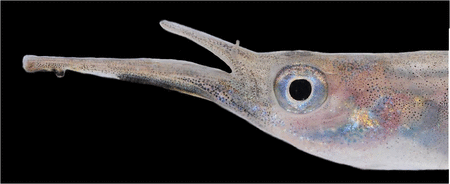 |
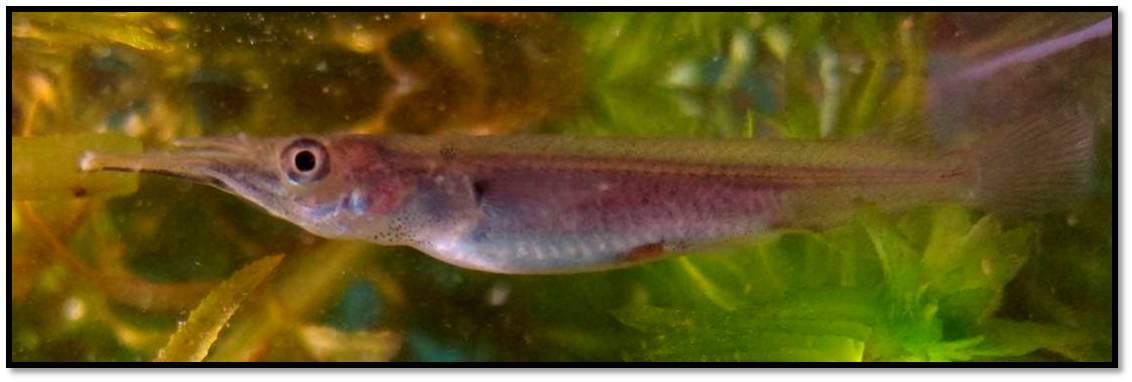 |
| Dermogenys collettei (Photo: Wilfred & Chirstopher (C)) |
Introduction
Dermongenys collettei or the Pygmy halfbeak belongs to a group of halfbeaks that are widely distributed across Southeast Asia [1] . As the halfbeak name implies, these fishes have an unusual lower jaw that is noticeably longer and protrudes beyond their upper jaw. This elongated lower jaw contains sensory receptors for the fish to sense its surroundings. The half-beak condition of these fishes become more prominent as the fish matures [2]. Males Dermogenys are known to be aggressive towards each another, hence members of this genus are sometimes used as fighting fishes [3]. Pregnant females of Dermogenys collettei give birth to live young that resembles a miniature adult, but without the prominent asymmetrical beak condition [4]. Recent phylogenetic studies suggest that this half-beak form is the basal condition within the taxon Beloniformes.Name
Scientific name [5]
Synonyms
Common/Vernacular names English
Malay
For more information on identification, click here. |
Biology
Feeding habits
Dermongenys collettei are surface-dwellers that feed mostly on small floating larvae and adult insects that have drifted by or landed onto the water surface [6]. A member of the genus, Dermogenys pusilla, was observed to prey fairly extensively on mosquito larvae, flies (dipterans), ephemeropterans (mayflies) and hymenopterans (ants)[7] [18]. These fishes were also observed to approach prey item from the side of the jaws rather than the front [8]. Studies on Dermogenys pusilla showed that the elongated lower jaws of this group of halfbeaks contain mechanoreceptive neuromasts to detect movements, and may also contain taste buds for sensing chemicals [4].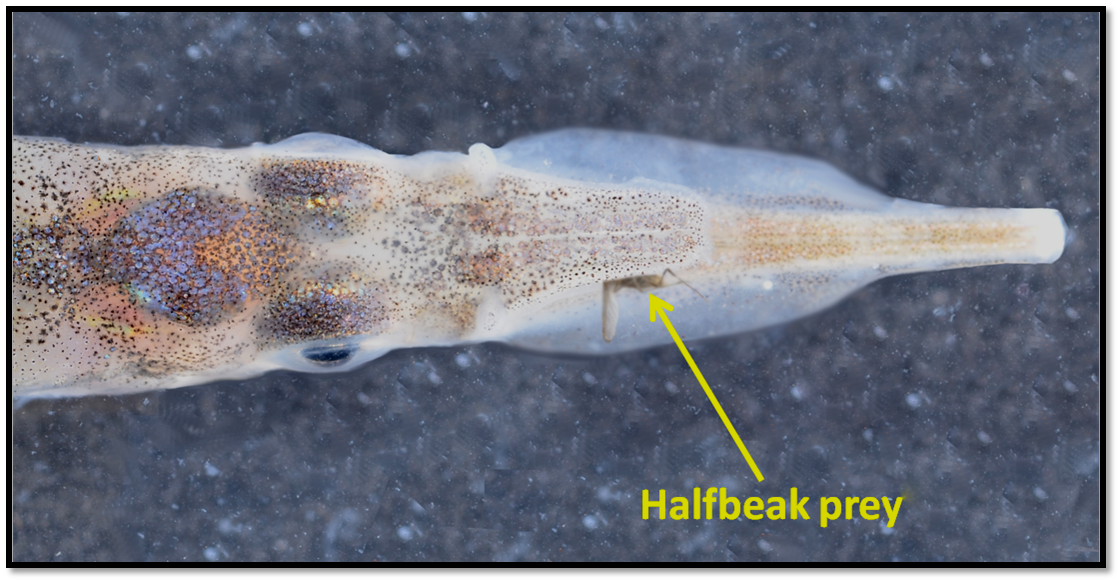 |
|
| Dermogenys collettei feeding on food items on the surface (Video: Wilfred (C)) |
Dermogenys collettei capturing food from side of mouth (Photo: Wilfred (C)) |
Behaviour
Dermogenys collettei are gregarious surface feeders that are often found together near the banks of water bodies [6]. Aggressive behaviour between male fishes are frequently documented from species in this genus that are sold in the aquarium trade, such as Dermogenys pusilla. Male fishes display a variety of combative behaviour such as threatening postures, biting, mouth fighting and chasing rivals. These fishes may also lock jaws during fights. Male fishes were found to display a dominance hierarchy in aquarium settings where only the dominant male is allowed near the female [4].| A male Dermogenys collettei defending its territory (Video: Wilfred (C)) |
Two male Demogenys pusilla fighting (Video: Youtube) |
Reproduction
The major elements of courtship for Dermogenys begin with males swimming towards the female and may involve nipping of her fins. Fin nipping may induce the female to stop or slow down her movement, hence giving the male a chance to copulate. The copulation process for Dermogenys occurs very quickly, where male fishes were observed to bend their body around the female and pushes onto her. Unreceptive females were observed to threaten and even attack her suitors. The specific process of insemination is unknown, likewise whether the spermatozuegmata (sperm packet) is deposited externallyon, near or into the genital opening of the female by the male's andropodium (modified anal fin) [4].
| A male Dermogenys collettei courting female fishes (Video: Wilfred (C)) |
Unreceptive female Dermogenys pusilla fighting off a male suitor (Video: Youtube) |
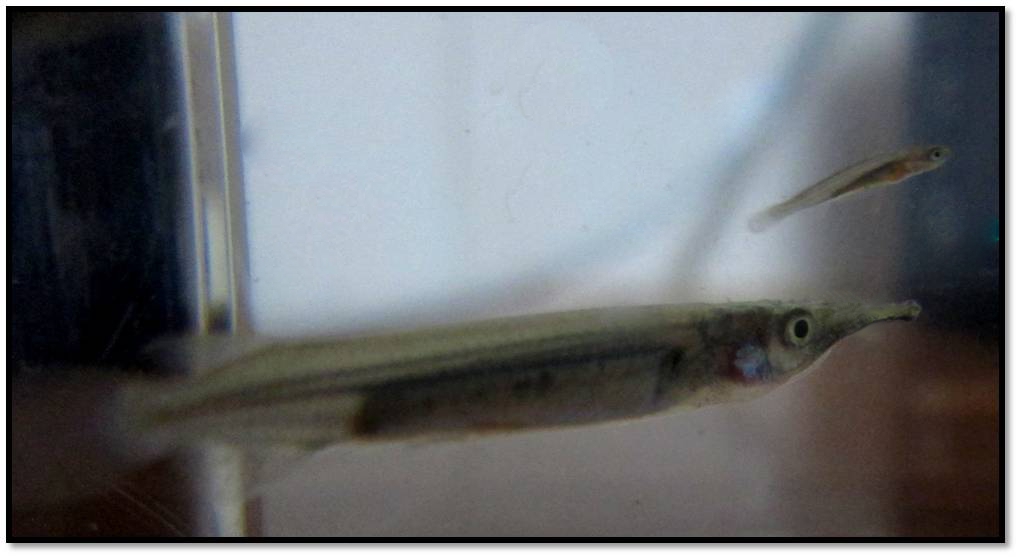 |
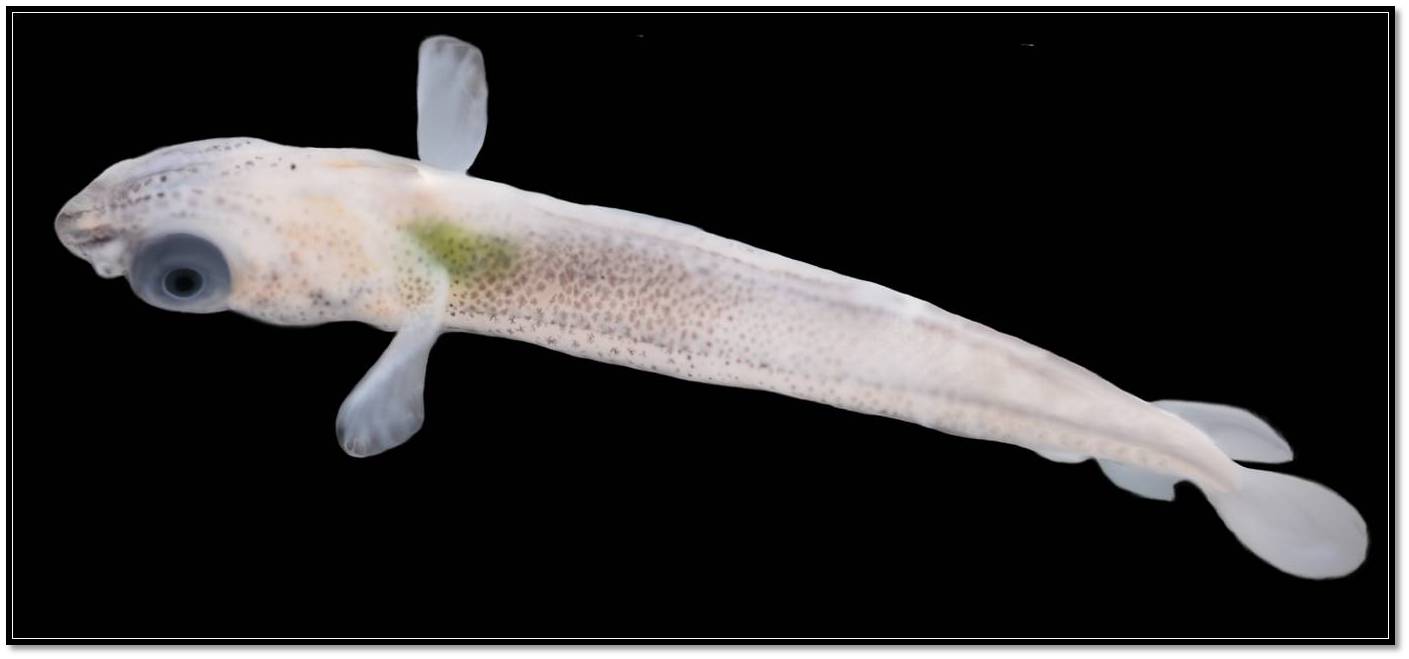 |
| Female Dermogenys collettei with new born fry (Photo: Wilfred (C)) |
New born Dermogenys collettei (Picture: Wilfred & Christopher (C)) |
Growth
Larval halfbeaks have short jaws without prominent asymmetrical beak condition. As the fish matures, the lower jaw elongates to form the half-beak condition [9]. 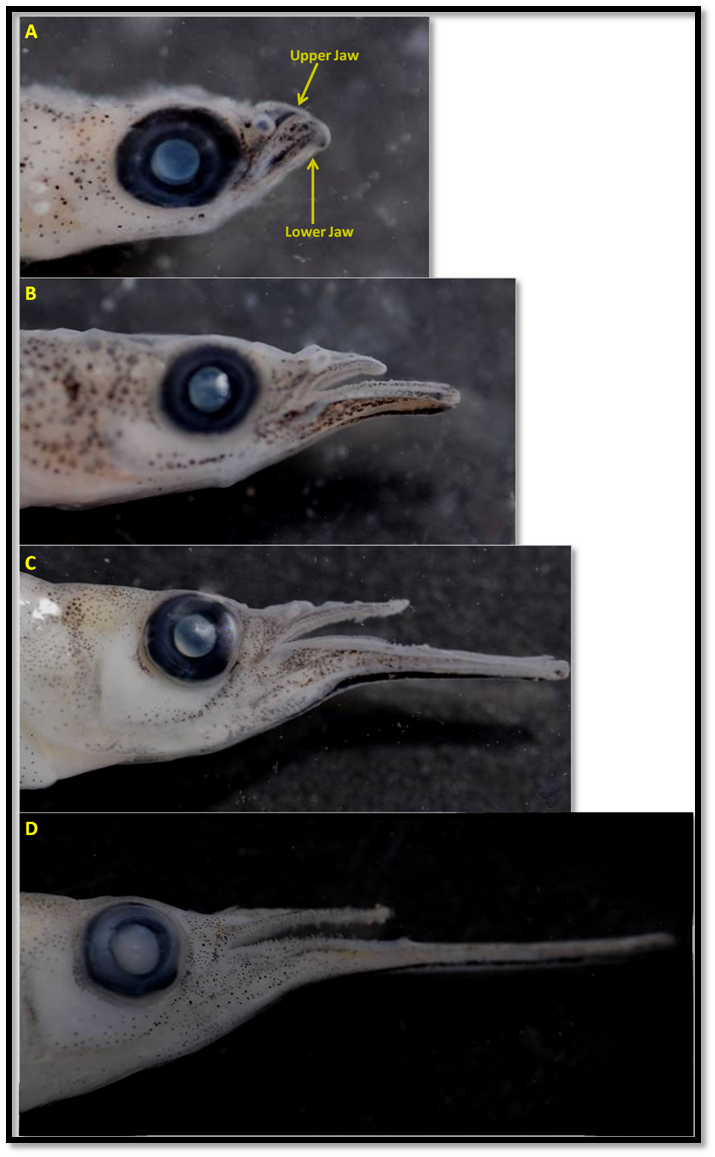 |
| Preserved specimens of Dermogenys collettei showing jaw development from; A) Larval stage; B) young juvenile; C) juvenile; D) adult (Photo: Wilfred & Christopher (C)) |
Habitat
Dermogenys collettei are found in small streams and ponds ranging from fresh to brackish water in both forested and open areas. Fishes occupy the water surface and are frequently found near to the banks of water bodies. Specimens caught in Brunei were found in mangrove streams with acidic water of pH 3.8 [6][10].| Stream with Dermogenys collettei found in both open and forested areas (Photo: Wilfred (C)) |
Underwater view of Dermogenys collettei stream habitat (Photo: Wilfred (C)) |
Distribution
Local
| Two species of halfbeaks are found in the freshwater streams in Singapore [6]. For more information on identification, click here. Local populations of Dermogenys collettei are found in:
Local populations of Hemirhamphodon pogonognathus:
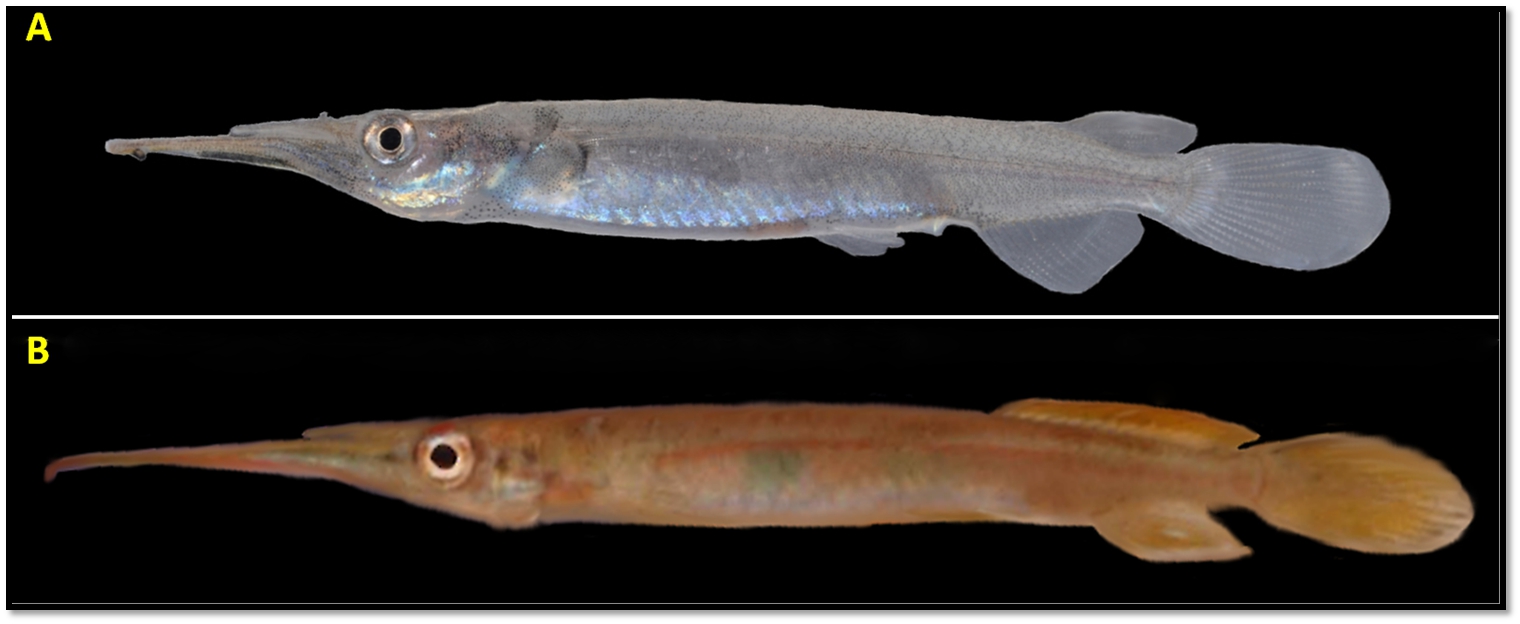 |
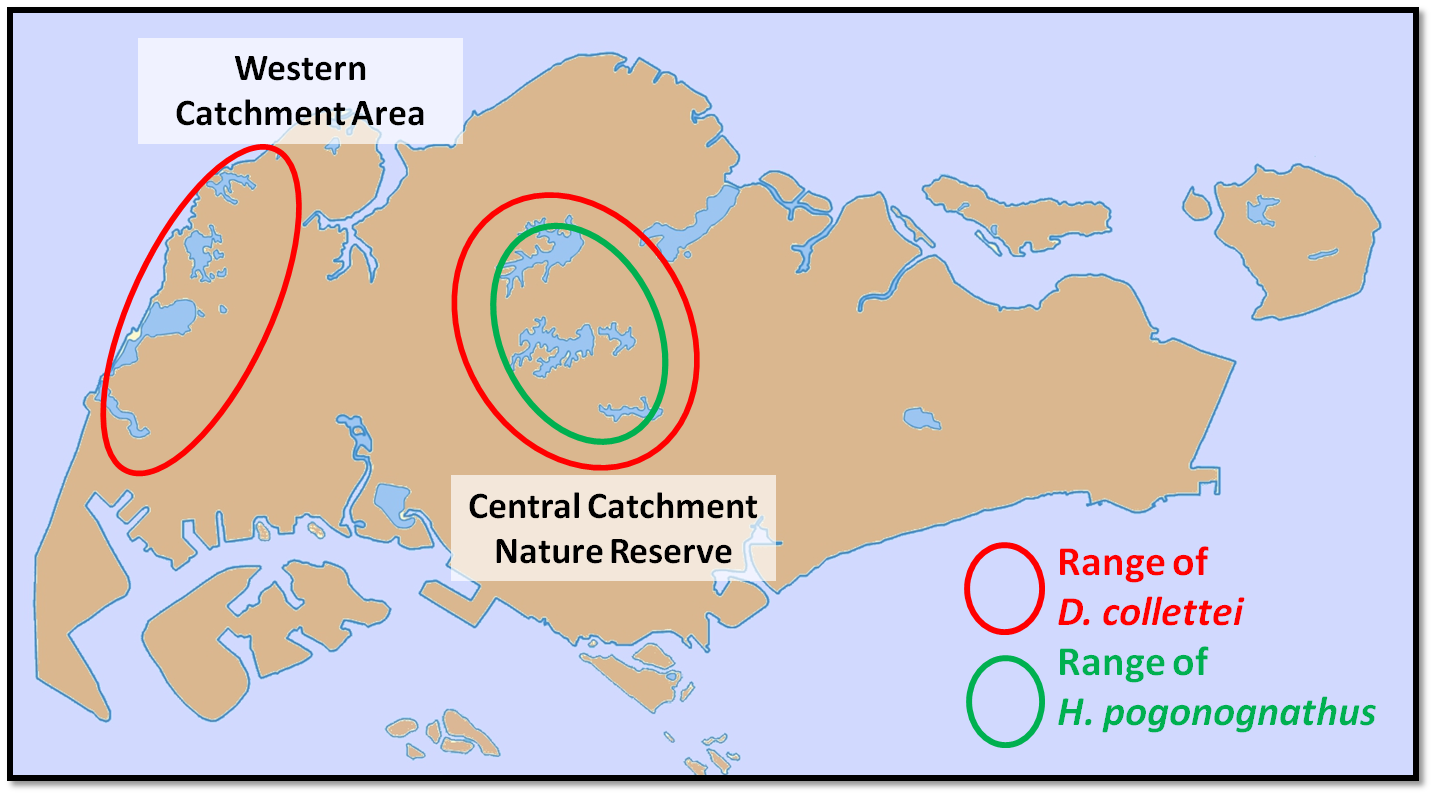
|
| A) Dermogenys collettei; B) Hemirhamphodon pogonognathus (Photo: Wilfred (C)) |
Local Dermogenys collettei distribution (Map outline adapted from Wikipedia Link |
Global
| About 10 members of the genus Dermogenys and 6 members of the genus Hemirhamphodon are found across Southeast Asia [10] [11]. Dermogenys collettei is found in many parts of Southeast Asia including:
|
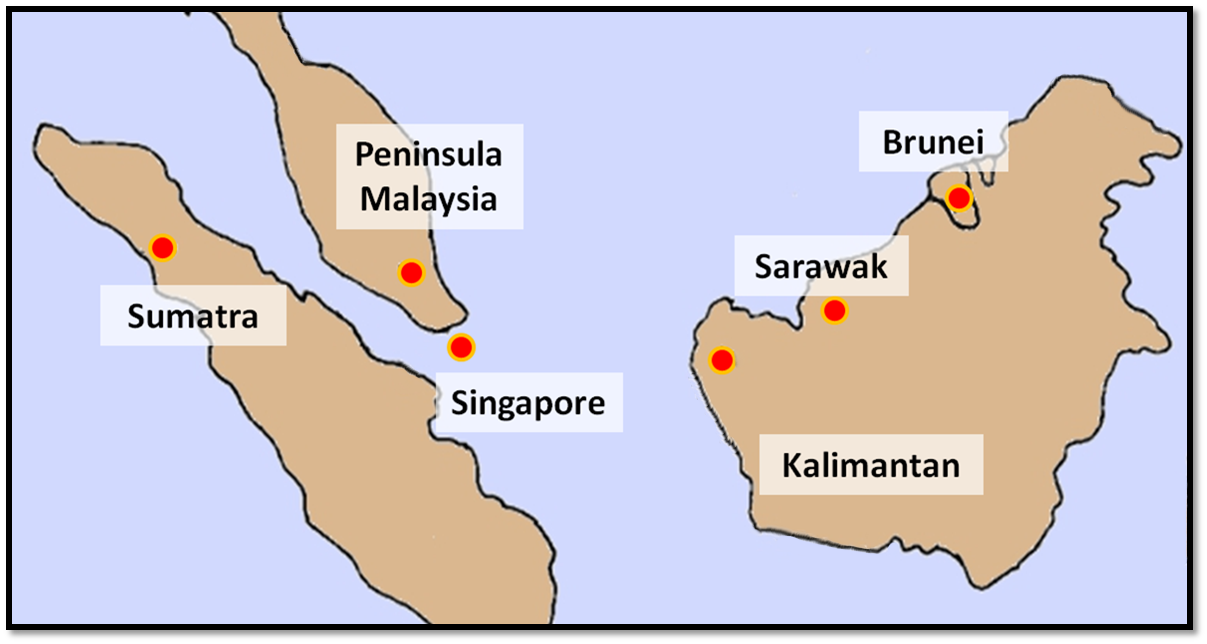 |
| Distribution of Dermogenys collettei (Map:Wilfred (Information adapted from Meisner, 2001)) |
Description
| Dermogenys collettei has a greyish slender body that grows to about 6 cm. Mature female fishes are larger than males. The dorsal fin of Dermogenys collettei originates behind the anal fin origin and may have red markings [6]. |
 |
| Adult female and male Dermogenys collettei (Photo: Wilfred & Christopher (C)) |
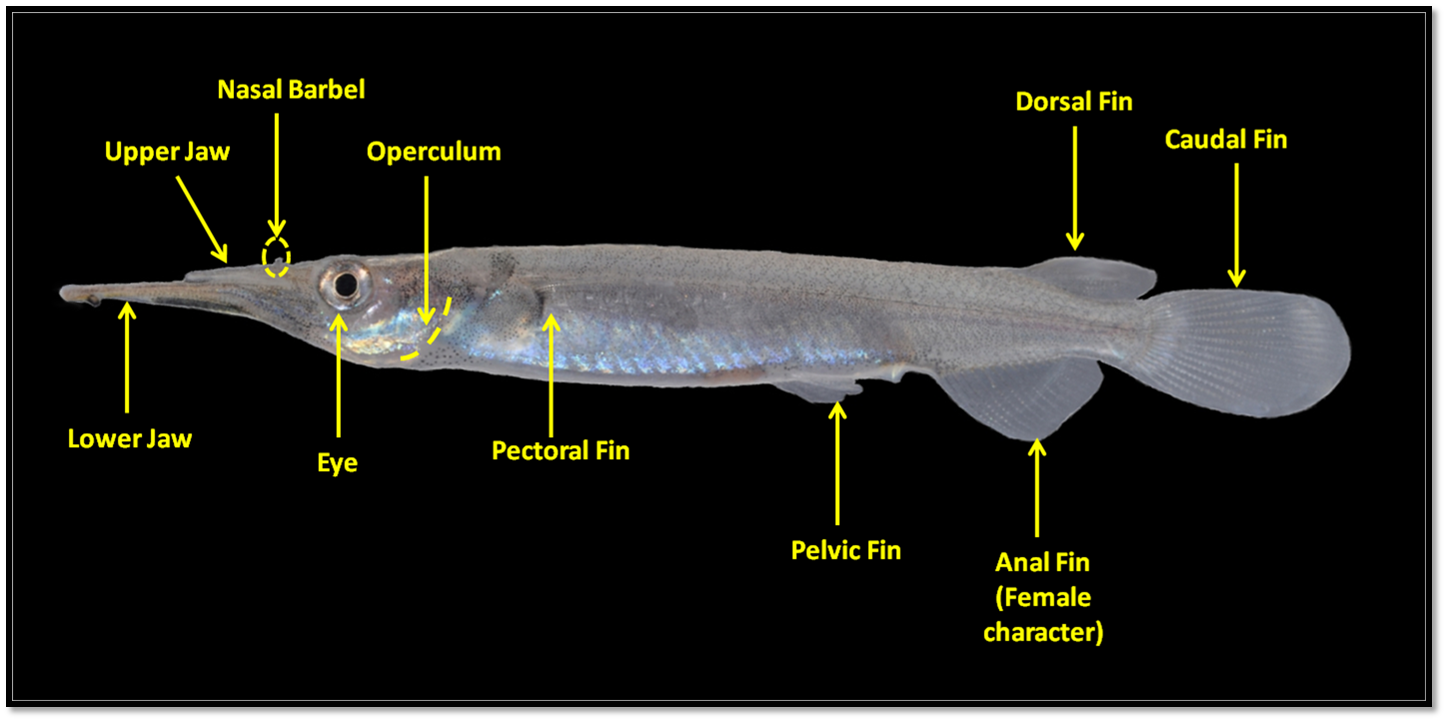 |
| Lateral view of Dermogenys collettei (Photo: Wilfred and Christopher (C)) |
Jaw
|
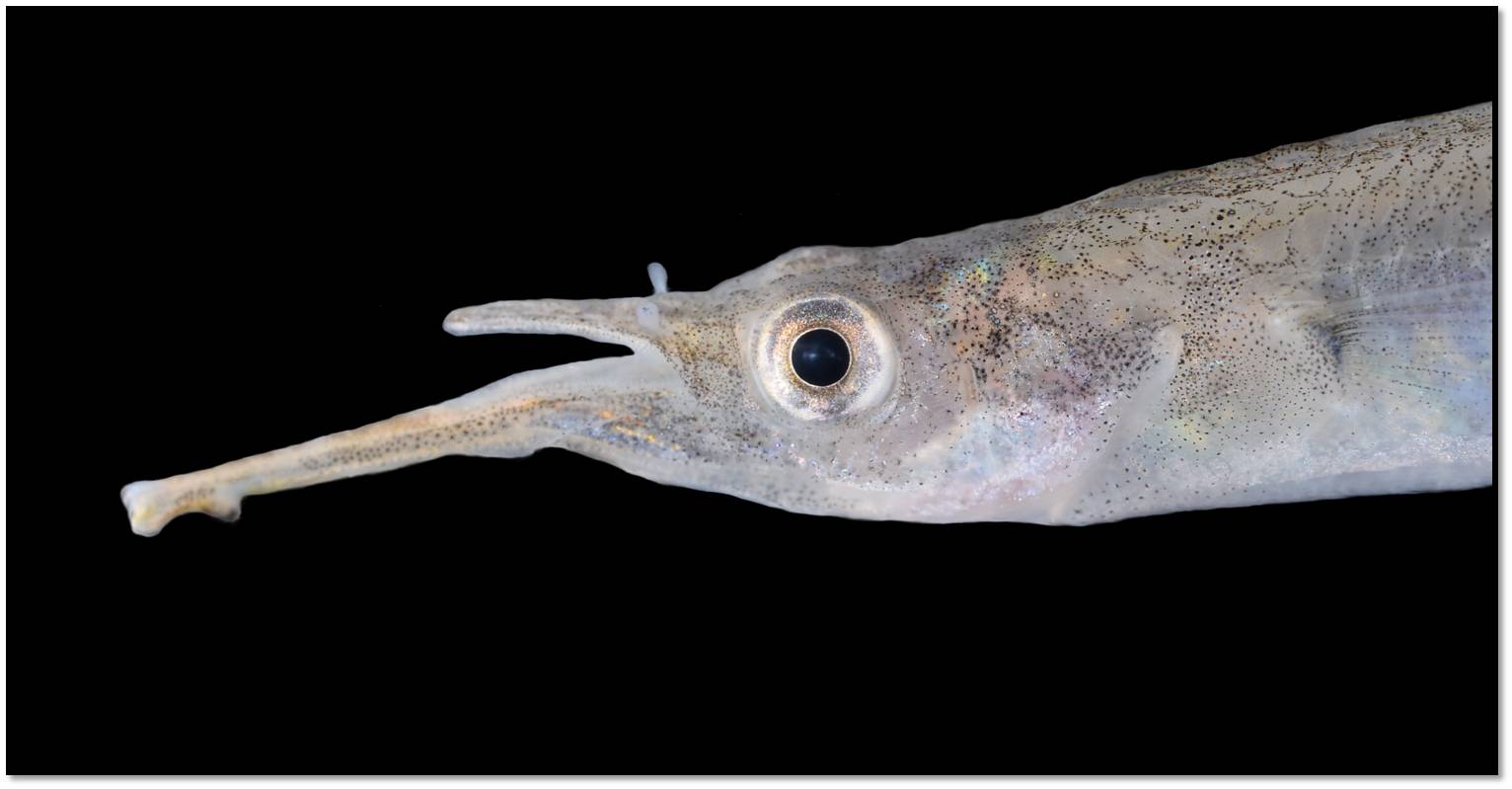 |
|
| Jaw of Dermogenys collettei (Photo: Wilfred and Chrisopher (C)) |
||
Upper Jaw
|
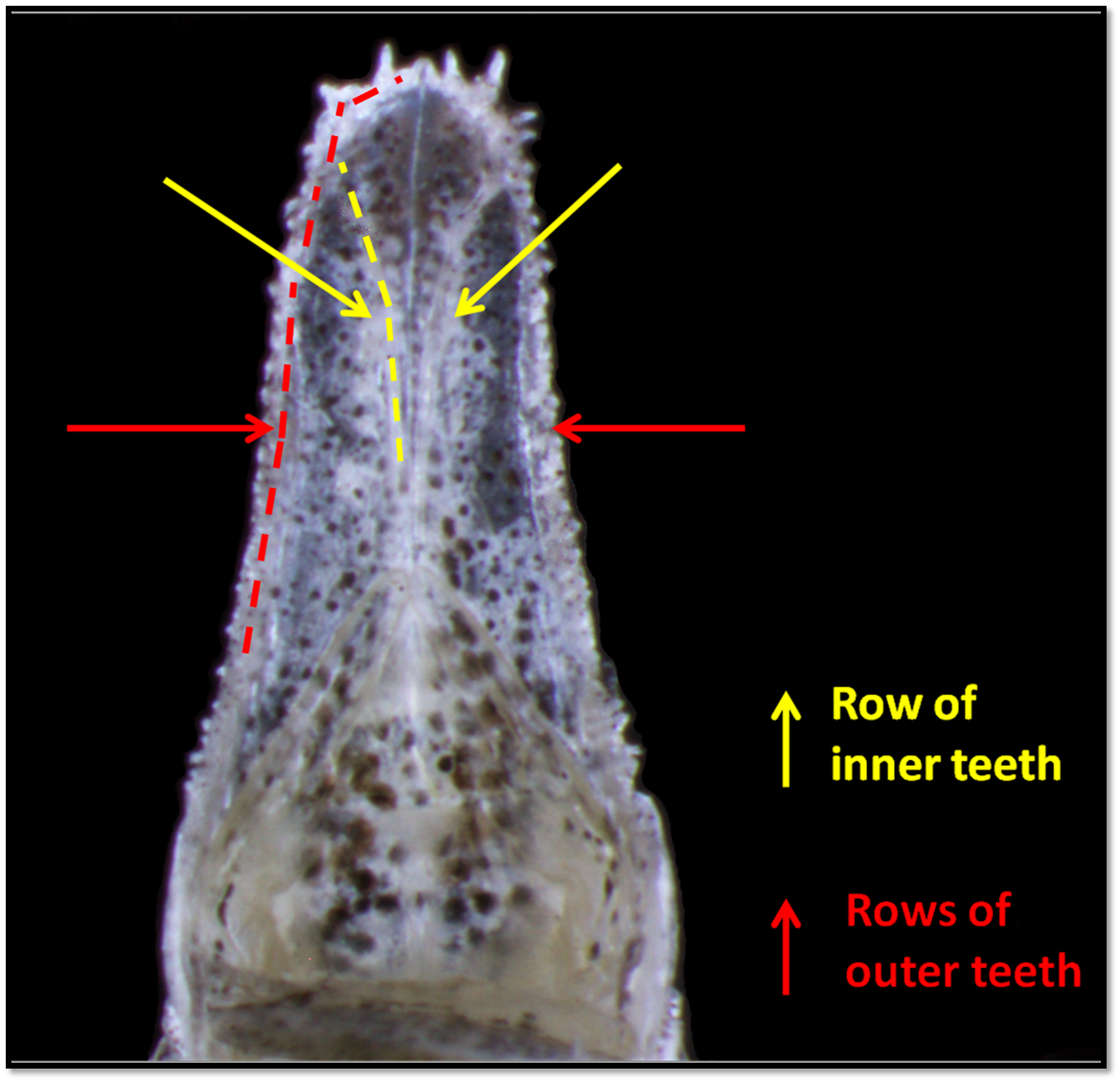 |
|
| Oral dentition on premaxilla plate (upper jaw) of Dermogenys collettei with outline on half of the upper jaw (Photo: Wilfred (C)) |
||
Lower Jaw
|
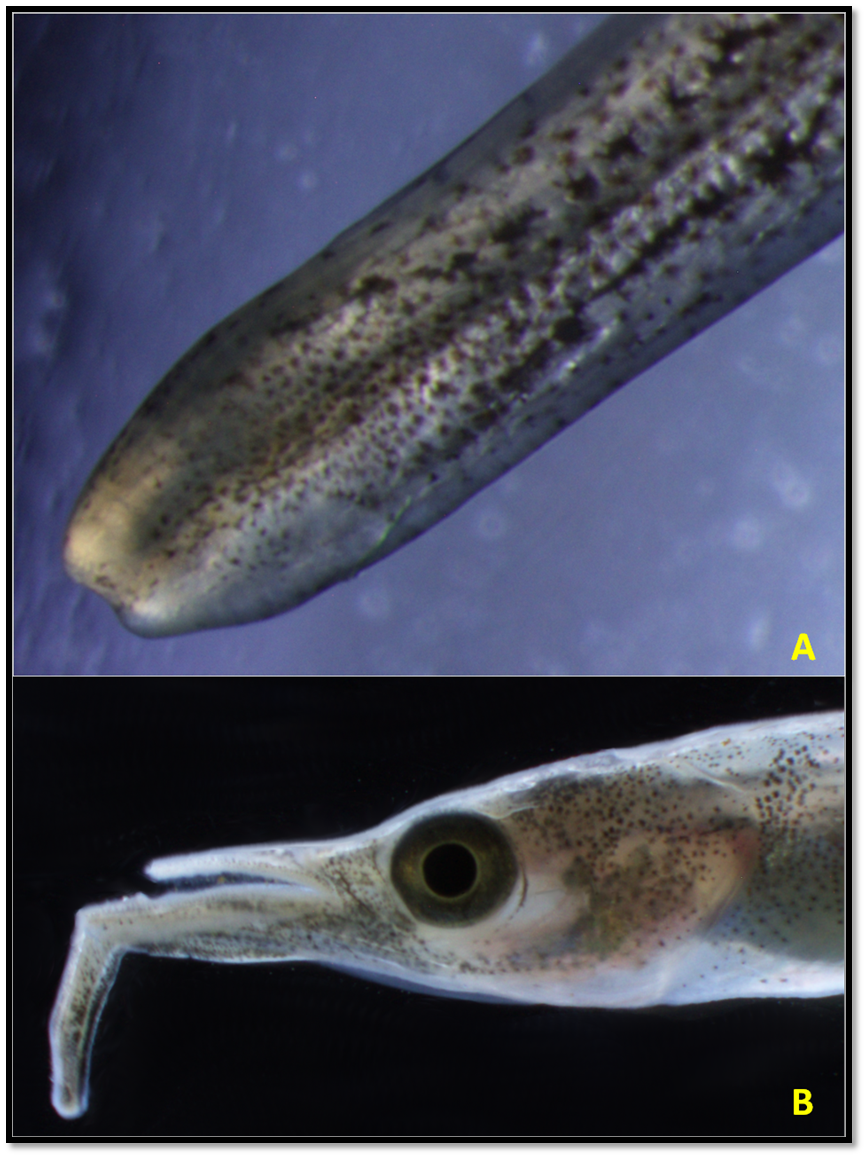 |
|
| A) Tip of lower jaw of Dermogenys collettei; B) Halfbeak with lower jaw broken (Photo: Wilfred (C)) |
||
Eye |
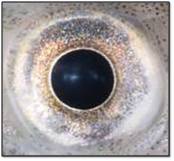 |
|
| Eye of Dermogenys collettei (Photo: Wilfred & Christopher (C)) |
||
Nasal Fossa
|
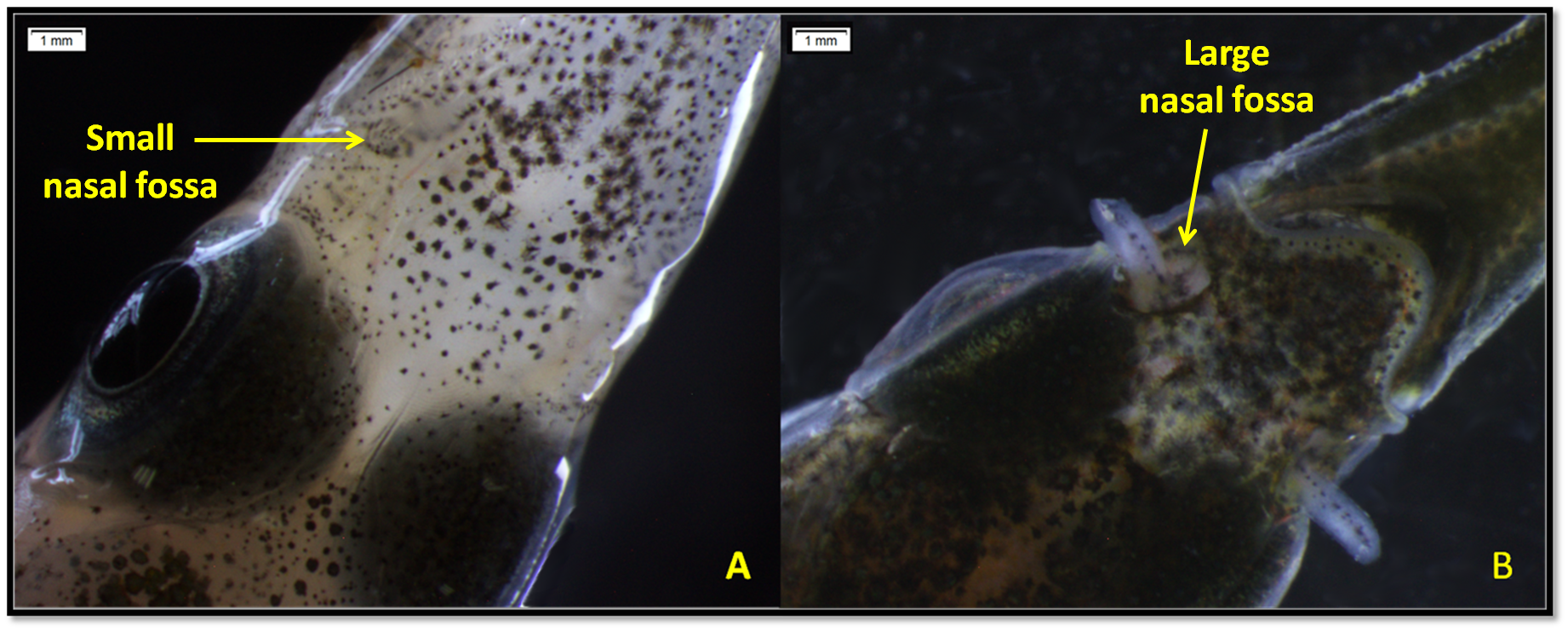 |
|
| Nasal fossa of halfbeaks, reflected as a small ring; A) Dermogenys collettei; B) Marine halfbeak(Photo: Wilfred (C)) |
||
Nasal Barbel
|
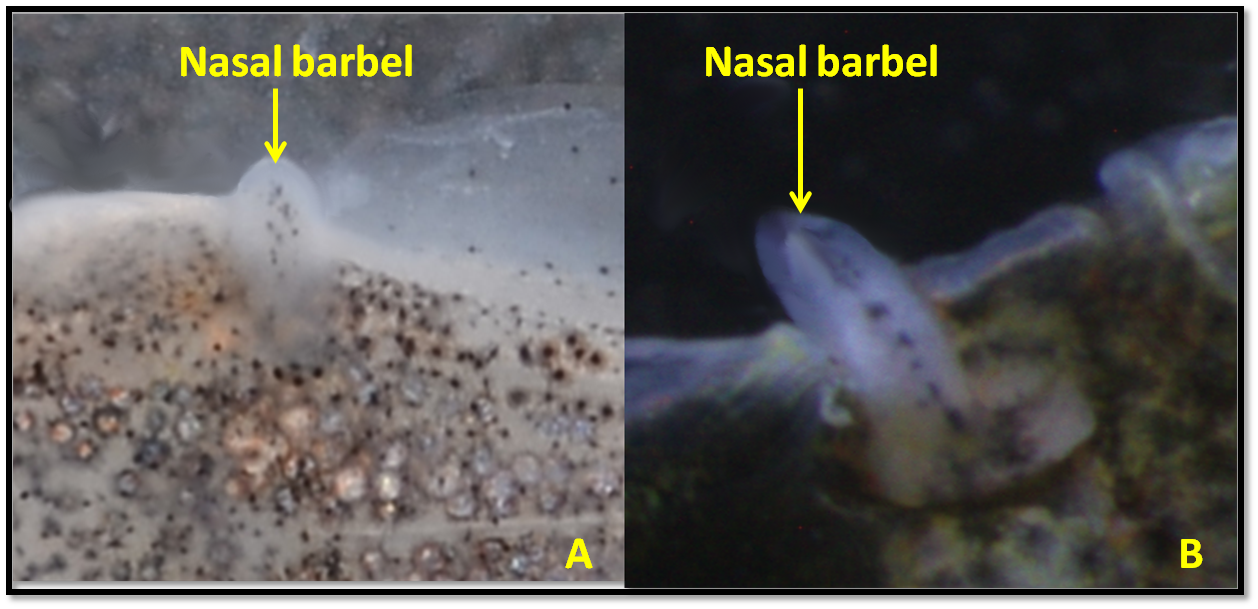 |
|
| Nasal barbel of halfbeaks; A) Dermogenys collettei; B) Marine halfbeak (Photo: Wilfred (C)) |
||
Anal Fin
|
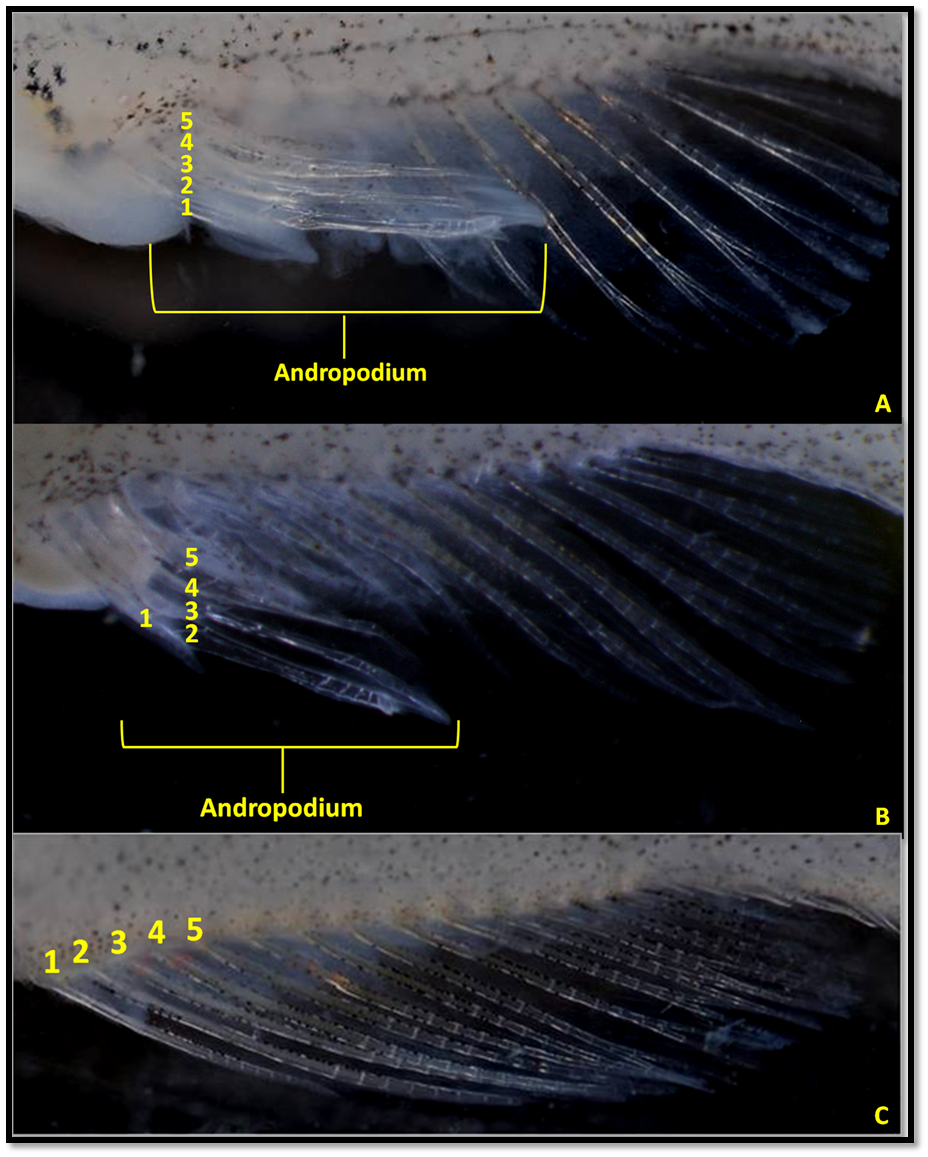 |
|
| Anal fin of Dermogenys collettei with with first 5 fin rays numbered; A) Retracted anal fin of male andropodium;B) Extended anal fin of male andropodium; C) Anal fin of female (Photo: Wilfred & Christopher (C)) |
Diagnosis
Identification of local halfbeaks
| Dermogenys collettei: anal fin originates before the dorsal fin origin Hemirhamphodon pogonognathus: anal fin originates behind dorsal fin, presence of a fleshy tip on the lower jaw that curves downward [6] |
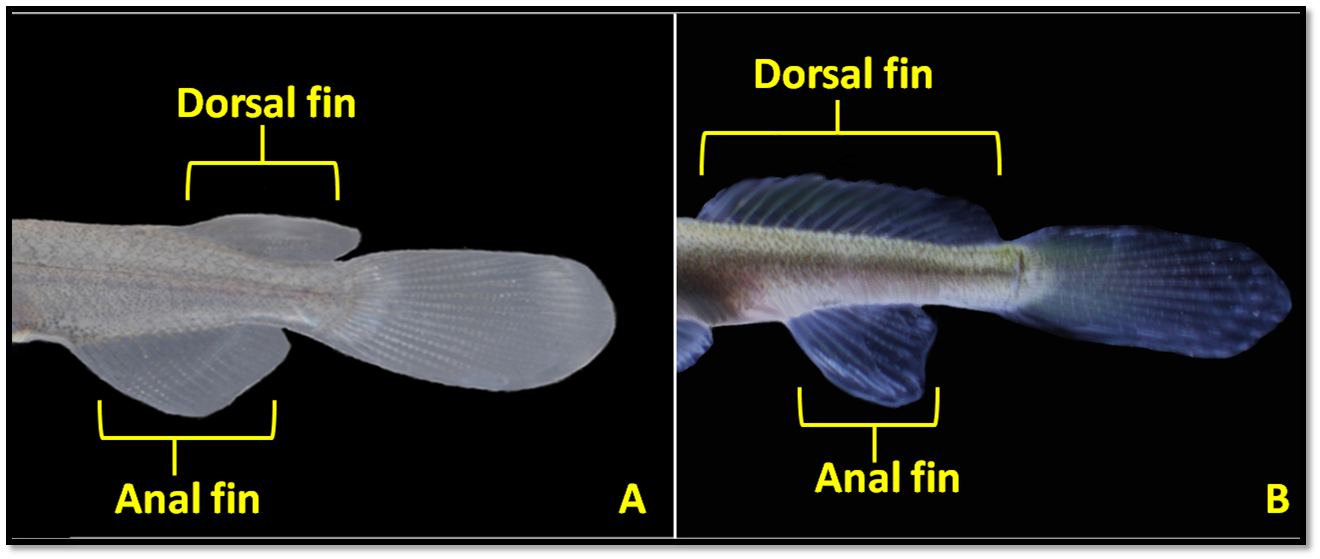 |
| Comparison of the origin of anal fin; A) Dermogenys collettei; B) Hemirhamphodon pogonognathus (Photo: Wilfred (C)) |
 |
| A) Dermogenys collettei with no fleshy tip on jaw; B) Hemirhamphodon pogonognathus with fleshy tip on lower jaw (Picture: Wilfred (C)) |
Derrnogenys can be distinguished from other genera in Hemiramphidae by [10]
- unique row of teeth located behind the rows of outer teeth that extend medially in a concave row to approximately half the length of the premaxilla
- expanded endopterygoid
- shortened, expanded autopalatine
- distinct geniculus on second anal-fin ray in males beginning at segment three or four
- gestation is entirely intrafollicular
- large spermatozeugmata due to the mode of spermatogenesis in which the spermatid nuclei become arranged in one layer evenly around the periphery of spermatocysts.
Species diagnosis [10]
The anal fin structure of male Dermogenys collettei is closest to that of Dermogenys pusilla and can be distinguished by:
- Thicker spiculus divided into 4-6 segments (vs. <3)
- Proximal segments 4-6 of second anal-fin ray in males noticeably thicker along anterior edge
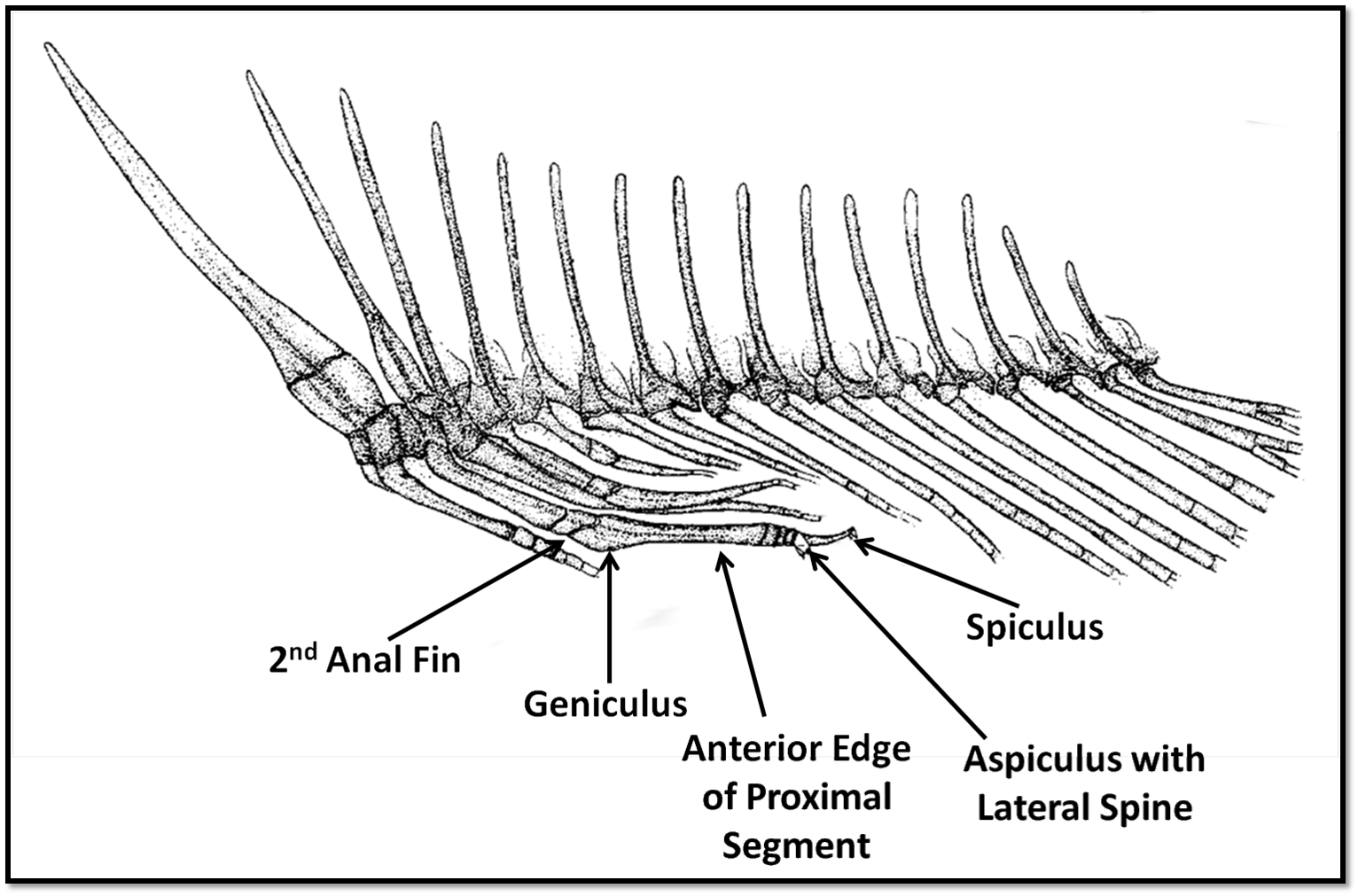 |
| Diagrammatic illustration of the andropodium of a male Dermogenys (Adapted from Meisner & Collette, 1998 [14] , illustration by Keiko Hiratsuka Moore and with approval from the Raffles Bulletin of Zoology) |
Trade
AquariumDermogenys are quite commonly traded as aquarium fishes and some of the more common species would include Dermogenys pusilla, Dermogenys siamensis and Dermogenys sumatrana [15]. However, different species are frequently traded under the umbrella name of Dermogenys pusilla, leading to confusion over species identity [16]. Names like 'Golden' or 'Sliver' halfbeaks' are given depending on the colouration of the fish. In some countries such as Thailand, Dermogenys are also used as fighting fishes for gambling [3]. 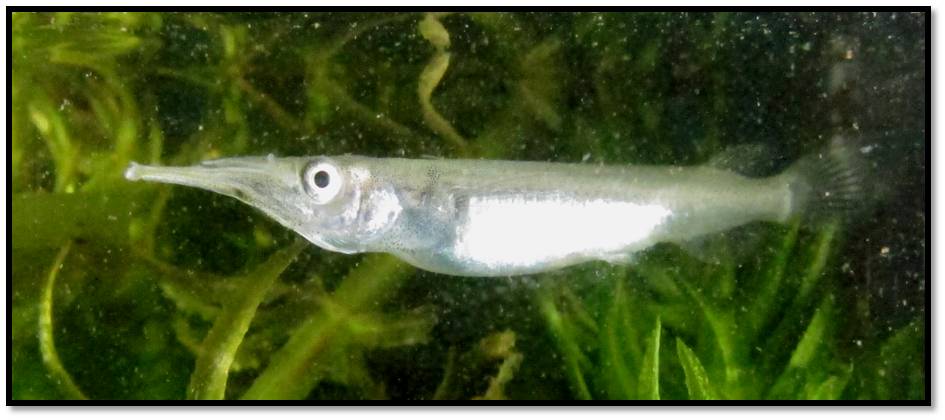 FoodDermogenys are commonly consumed by locals in Cambodia where the fish was found to be high in vitamin A [22]. 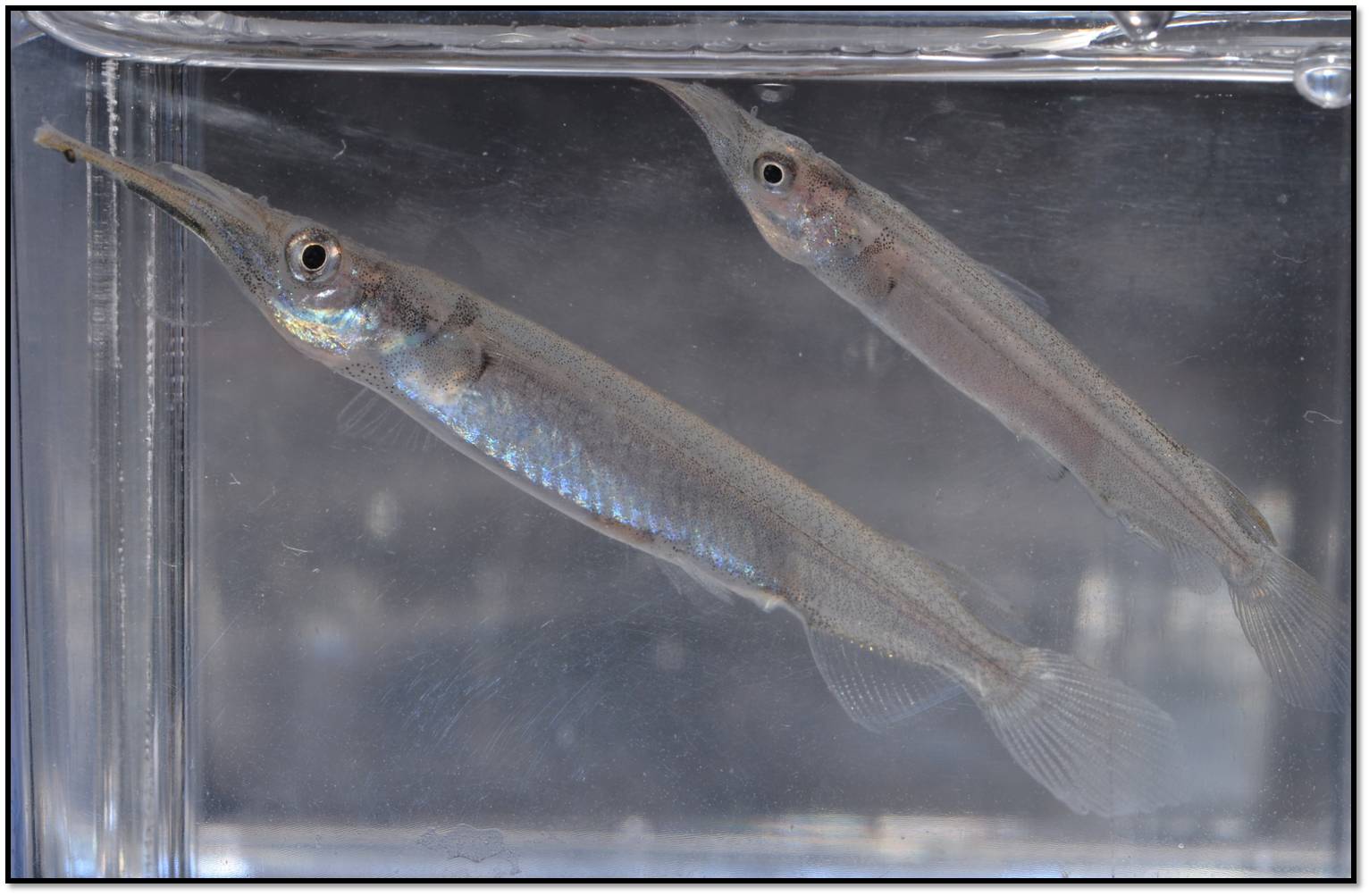 |

Taxonavigation
Animalia
|
|
|
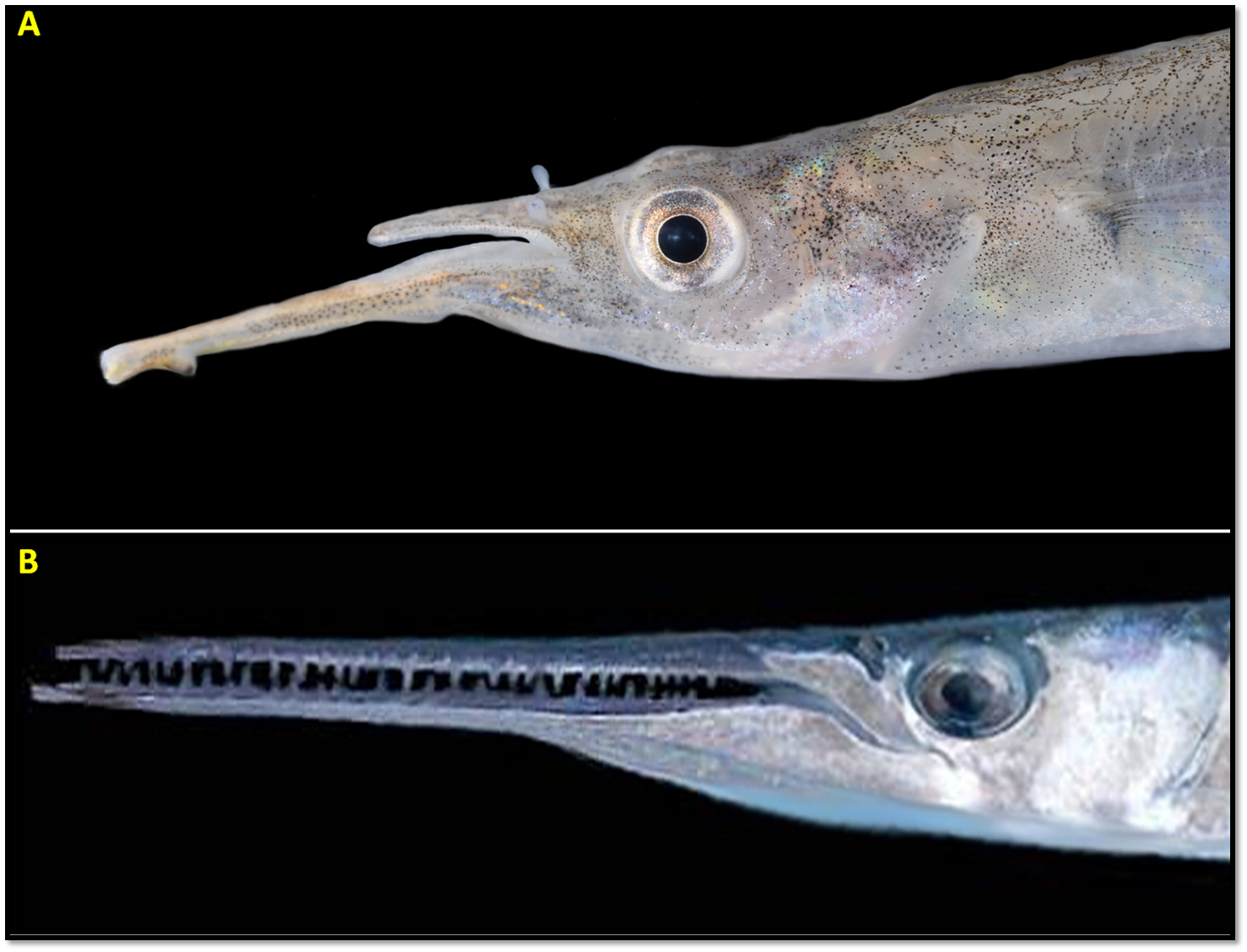 |
| A) Jaw of Dermogenys collettei; B) Jaw of a needlefish (Photo: Wilfred & Christopher (C)) |


Taxonomy
Relevance
Finding out the evolutionary relationship between different species offers insight to speciation events that have occurred. In addition, information on the evolutionary history of organisms can be used as a criterion in conservation. Conserving an area with many different groups of organisms not only helps preserve a wider range of different species, but also their evolutionary history. Hence, areas with only a single or few groups of closely related organisms should have a lower conservation priority than areas with many different groups of organisms.
Meisner, 2001 performed a phylogenetic analysis on 28 taxa (10 species of Dermogenys and 13 species of Nomorhamphus) based on a data matrix comprising of 45 characters and constructed a strict consensus phylogenetic tree using the branch and bound option in PAUP [10]. Nested within node A, the monophyly of Dermogenys stricto sensu, is supported by 3 characters:
The genera (Dermogenys) is divided into 2 clades; Dermogenys pusilla group (Node B) and Dermogenys orientalis group (Node C). Dermogenys collettei is nested within the Dermogenys pusilla species group clade (Node B), sharing 2 common characters:
The data used in this study was unable to determine the relationship between species within a clade. More data such as using DNA barcoding may be needed to provide better resolution to the relationship between sister taxa [21]. |
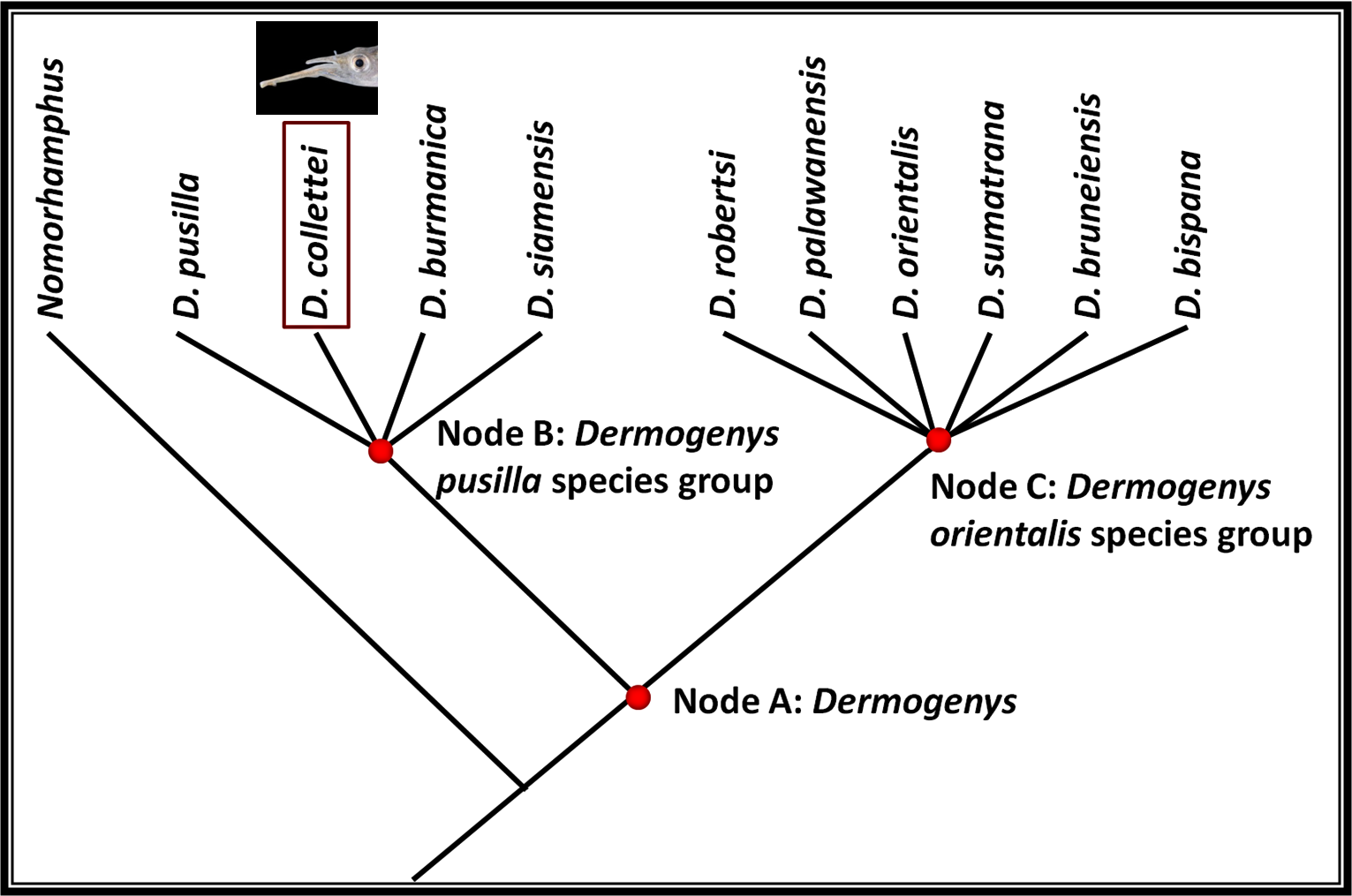 |
| Simplified phylogenetic tree of Dermogenys (Diagram: Wilfred (Adapted from Meisner, 2001)) |
Type information
A holotype is an important specimen which the formal description of a species is based on, and should possess the typical characteristics of that particular taxon. Referring to holotype specimen is therefore the best way to identify unknown specimens. Due to the importance of holotype specimens, designating the correct specimen as the holotype is extremely important for taxonomists. A paratype is another specimen of the same type series not designated as the holotype, and there can be multiple paratype specimens.The holotype for Dermogenys collettei is collected from Kuching, Sarawak in 1994. It is kept in the Raffles Museum of Biodiversity Research (RMBR), specimen number ZRC 37790, in Singapore. The paratype (a female) is collected with the holotype and is also stored in the RMBR, specimen number ZRC 46161 [10].
 |
| Preserved specimen of Dermogenys collettei (Photo: Wilfred and Christopher (C)) |
Conservation
Dermogenys collettei is not yet assessed by IUCN Red List. Some species from the genus Dermogenys that are in the Red list includes:- Dermogenys burmanica (Least Concern)
- Dermogenys siamensis (Least Concern)
Anthropogenic activities are major threats to some freshwater halfbeaks from the genus Dermogenys and Nomorhamphus [24]. As these fishes are commonly traded, the source of these fishes should be monitored to ensure sustainable catch. More research are therefore required to protect these unique fishes.
 |
| Dermogenys collettei (Photo: Wilfred (C)) |
Comments
comments powered by DisqusLinks
- Dermogenys. Wikipedia
- Dermogenys collettei. Torres, A.G., 2012. Fishbase
- Family Hemirhamphidae. Lim, K.K.P. & Ng,P.K.L., 1990. A guide to freshwater fishes of Singapore
- Freshwater fishes in Singapore. National Parks Board, Singapore
- Halfbeaks (Hemirhamphidae). Tan, R. 2008. WIld Singapore
- Pygmy halfbeak. Baker, N., 2012. Ecology Asia
- Wrestling Halfbeak (Dermogenys pusilla). Aquarium Life
Literature and References
1. Meisner, A. D. & Burns, J. R. 1997. Testis and andropodial development in a viviparous halfbeak, Dermogenys sp. (Teleostei: Hemiramphidae). Copeia. 1997(1): 44-52.
2. Collette, B. B., McGowen, G. E., Parin, N. V. & Mito, S., 1984. Beloniformes: development and relationships. In: Mosher, H. G., Richards, W. J., Kendall, A. W. & Richardson, S. L., eds. Ontogeny and systematics of fishes. American Society of Ichthyologists and Herpetologists Special Publication, p. 335-354.
3. Lim, K. K. P. & Ng, P. K. L., 1990. A guide to the freshwater fishes of Singapore. The Science Centre, Singapore, p. 70.
4. Greven, H., 2010. What Do we know about reproduction of internally fertilizing halfbeaks (Zenarchopteridae)? In: Uribe, M. C. & Grier, H. J., eds. Viviparous Fishes II. New Life Publications, Homestead, Florida.
5. Meisner, A. D. & Burns, J. R., 1997. Viviparity in the halfbeak Genera Dermogenys and Nomorhamphus (Teleostei: Hemiramphidae). Journal of Morphology. 234: 295–317.
6. Baker, N. & Lim, K. K. P., 2008. Wild animals of Singapore. Draco Publishing and Distribution Pte Ltd, Singapore, p. 40.
7. Usman, S. & Soemarlan, S., 1974. Pengamatan di laboratorium mengenai ikan-ikan pemakan jentik nyamuk. Buletin Penelitian Kesehatan. 2.
8. Greven, H., 2006. Viviparous halfbeaks. Notes on structural peculiarities, feeding, and reproduction. Biologie der Aquarienfische. Tetra Verlag GmbH, p. 271-296.
9. Lovejoy, N. R., Iranpour, M. & Collette, B. B., 2004. Phylogeny and Jaw Ontogeny of Beloniform Fishes. Integrative and Comparative Biology. 44: 366–377.
10. Meisner, A. D., 2001. Phylogenetic systematics of the viviparous halfbeak genera Dermogenys and Nomorhamphus (Teleostei: Hemiramphidae: Zenarchopterinae). Zoological Journal of the Linnean Society. 133: 199-283.
11. Catalogue of Life. 2012. Available online at: http://www.catalogueoflife.org/col/search/all/key/Hemirhamphodon/match/1 [Accessed on 25th October 2012]
12. Boughton, D. A., Collette, B. B. & Mccune, A. R., 1991. Heterochrony in jaw morphology of Needlefishes (Teleostei: Belonidae). Systematic Zoology. 40(3): 329-354
13. Reckel, F., Melzer, R. R., Parry, J. W. L. & Bowmaker, J. K., 2002. The retina of five atherinomorph teleosts: Photoreceptors, patterns and spectral sensitivities. Brain, Behaviour and Evolution. 60:249-264.
14. Meisner, A. D. & Collette, B. B., 1998. A new species of viviparous halfbeak, Dermogenys bispina (Teleostei: Hemiramphidae) from Sabah (North Borneo). The Raffles Bulletin of Zoology. 46: 373-380.
15. Monks, N. Halfbeaks: Family Hemiramphidae. Available online at: http://www.wetwebmedia.com/ca/volume_4/V4I1/halfbeaks/Halfbeaks.htm [Accessed on 25th October 2012]
16. Monks, N. 2011. 7 forgotten livebearers. Tropical Fish Magazine. Available online at:
http://www.tfhmagazine.com/details/articles/7-forgotten-livebearers-full-article.htm [Accessed on 26th October 2012]
17. Encyclopedia of Life. Dermogenys collettei. Available online at: http://eol.org/pages/210958/names [Accessed online on 25th October 2012]
18.Ward-Campbell, B. M. S., Beamish, F. W. H. & Kongchaiya, C., 2005. Morphological characteristics in relation to diet in five coexisting Thai fish species. Journal of Fish Biology 67: 1266-1279.
19. Lovejoy, N. R., 2000. Reinterpreting recapitulation: Systematics of Needlefishes and their allies (Teleostei: Beloniformes). Evolution. 54(4): 1394-1362.
20. Greven, H., Wanninger, A. C. & Clemen, G., 1997. Dentigerous bones and dentition in the hemiramphid fish Dermogenys pusillus (Atheriniformes, Teleostei). Annals of Anatomy-Anatomischer Anzeiger. 179(1): 21-32.
21. de Bruyn, M., Grail, W., Barlow, A. & Carvalho, G. R., 2010. Anonymous nuclear markers for Southeast Asian halfbeak fishes (Dermogenys). Conservation Genetics Resources. 2(1): 325-327.
22. Roos, N., Chamnan, C., Loeung, D., Jakobsen, J. & Thilsted, S. H., 2006. Freshwater fish as a dietary source of vitamin A in Cambodia. Food Chemistry. 103: 1104-1111.
23. Tan, H. H., Low, M. E. Y. & Lim, K. K. P., 2010. Fishes of the Marina basin, Singapore, before the erection of the Marina Barrage. The Raffles Bulletin of Zoology. 58(1): 137-144.
24. IUCN 2012. IUCN Red List of threatened species. Version 2012.2. Available online at: http://www.iucnredlist.org/search [Accessed online on 15th December 2012]
